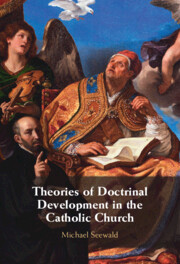Book contents
- Theories of Doctrinal Development in the Catholic Church
- Theories of Doctrinal Development in the Catholic Church
- Copyright page
- Contents
- Acknowledgements
- Introduction: What Is This Book About?
- 1 Defining Dogma and Development
- 2 The Bible: Both Product and Yardstick of Doctrinal Development
- 3 How the Early Church Reflected on Doctrinal Continuity and Change
- 4 Discussions in the Middle Ages on Changes to the Unchanging Faith
- 5 Theories of Doctrinal Development in the Nineteenth and Early Twentieth Century
- 6 The Twentieth Century: From Anti-Modernism to the Second Vatican Council
- 7 Overview and Outlook
- Epilogue: An ‘Obituary’ to the Church?
- Bibliography
- Index
2 - The Bible: Both Product and Yardstick of Doctrinal Development
Published online by Cambridge University Press: 18 February 2023
- Theories of Doctrinal Development in the Catholic Church
- Theories of Doctrinal Development in the Catholic Church
- Copyright page
- Contents
- Acknowledgements
- Introduction: What Is This Book About?
- 1 Defining Dogma and Development
- 2 The Bible: Both Product and Yardstick of Doctrinal Development
- 3 How the Early Church Reflected on Doctrinal Continuity and Change
- 4 Discussions in the Middle Ages on Changes to the Unchanging Faith
- 5 Theories of Doctrinal Development in the Nineteenth and Early Twentieth Century
- 6 The Twentieth Century: From Anti-Modernism to the Second Vatican Council
- 7 Overview and Outlook
- Epilogue: An ‘Obituary’ to the Church?
- Bibliography
- Index
Summary
Should a theological treatise like mine not begin with the Bible instead of with a history of concepts – after all, the Second Vatican Council demands that dogmatic theology ‘be so arranged’ that ‘biblical themes are proposed first of all’ (Optatam totius, No. 16)? According to the wish of the Council Fathers, scripture is to provide dogmatics with themes, and not vice versa, with the Council thereby criticizing the tendency to constrain and exploit the Bible for reasons of dogma. This was something that neo-scholasticism had done, for example, when it treated the Bible as a reservoir of dicta probantia, of statements proving the truth of dogmatic propositions. It threw in quotations from scripture where it was deemed they would help the argument. Franz Diekamp, the neo-Thomist already mentioned in the previous chapter, expresses this in almost disarming clarity when he states that because the magisterium is ‘the closest and most direct guide to the Catholic faith’ (regula proxima fidei), and the Bible, which always needs the ‘magisterium to safeguard and interpret it’, is only the regula remota fidei, reference to scripture is only of secondary importance in theology and could indeed be dispensed with completely (see Diekamp 1930: 64–65).
- Type
- Chapter
- Information
- Theories of Doctrinal Development in the Catholic Church , pp. 38 - 58Publisher: Cambridge University PressPrint publication year: 2023

